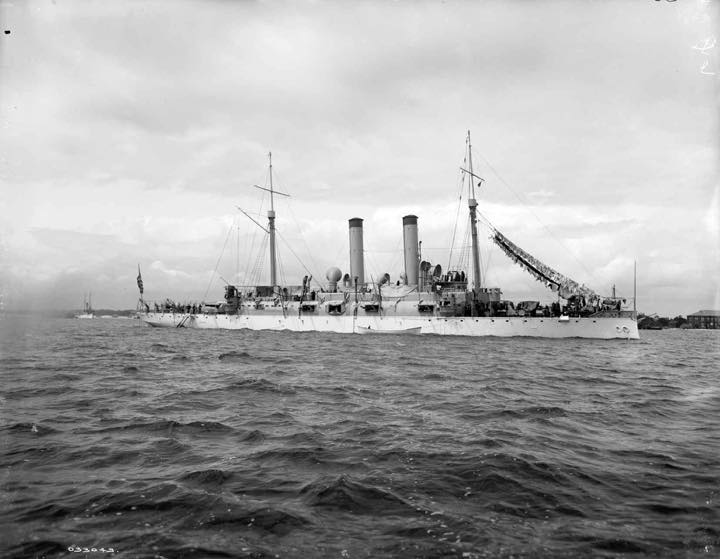USS Atlanta

Atlanta
II
(Protected Cruiser: dp. 3,189; 1. 288'6"; b. 42'2"; dr. 1910 1/2" (aft); s. 16.33 k.; cpl. 284; a. 2 8", 6 6", 2 6-pdrs., 2 3-pdrs., 2 1-pdrs., 2 47mm., 2 37mm., 2 Gatling guns; cl. Atlanta)
The second Atlanta-a protected cruiser and one of the first steel warships of the "New Navy" of the 1880's-was laid down on 8 November 1883 at Chester, Pa., by John Roach & Sons; launched on 9 October 1884; sponsored by Miss Jessie Lincoln, the daughter of Secretary of War Robert Todd Lincoln and granddaughter of President Abraham Lincoln; and commissioned at the New York Navy Yard on 19 July 1886, Capt. Francis M. Bunce in command.
She remained at New York fitting out and undergoing modifications until July of 1887 when she joined the North Atlantic Squadron. For a little over two years, she cruised the Atlantic coast, the Gulf of Mexico, and the West Indies. On 30 September 1889 she was reassigned to the Squadron of Evolution with which she voyaged to Europe and the Mediterranean that winter. On the return voyage the protected cruiser paid a friendship visit to the Republic of Brazil before returning to New York at the end of July 1890. There, she resumed duty along the east coast and in the West Indies. Between February and April of 1891, she cruised the Gulf of Mexico. From May to October, the ship operated along the Atlantic coast and participated in exercises and maneuvers at Boston and New York, training members of the Naval Militia. Between October 1891 and July 1892, she served successively along the east coast, in the West Indies, and in South American waters.
On 2 September 1892, the cruiser was transferred from the Squadron of Evolution back to the North Atlantic Squadron. Between December 1892 and February 1893, she operated in the West Indies protecting American interests. In March, April, and May, the warship participated in the naval review held at Hampton Roads, Va. In May and June, she returned to the Gulf of Mexico. On 18 July 1893, Atlanta was placed out of commission at Norfolk. There, she remained until recommissioned on 2 April 1894. She returned to duty on the North Atlantic station for the next 17 months. During that assignment, she put a landing party ashore at Boca del Toro, Colombia, on 8 March 1895 to protect American lives and property threatened by a Liberal Party revolt and the activity of filibusters. In September of 1895, she was placed out of commission at the New York Navy Yard where she was laid up for the next five years.
On 15 September 1900, she was placed back in commission at New York, Comdr. E. C. Pendleton in command. Late in October, the ship put to sea to join the South Atlantic Squadron off the coast of Brazil. She cruised those waters until November 1902 when she was transferred to the Caribbean Squadron. During the latter tour of duty, she again landed shore parties to protect American interests-first at Santo Domingo in April 1903 and then at Porto Bello, Panama, the following December. She made a voyage to the Mediterranean in 1904 and returned in October, via the western coast of Africa and Capetown, to the South Atlantic station. She arrived back at Hampton Roads on 26 December and, in January 1905, moved to Annapolis, Md., where she was placed in reserve on the 12th. Atlanta remained inactive only until 8 May, at which time she was returned to full commission for service in the Coast Squadron to participate in midshipman training missions.
In November 1905, the warship moved to Norfolk where she served as a barracks ship for sailors of the Torpedo Flortilla until 1909. At that time, she moved to Charleston, S.C., where she resumed duty as a barracks ship. On 23 March 1912, Atlanta was relieved of duty and, one month later, on 24 April 1912, her name was struck from the Navy list. The ship was sold at Charleston on 10 June 1912 to Frank Rijsdyk's Scheepsslooperij.
 >
>